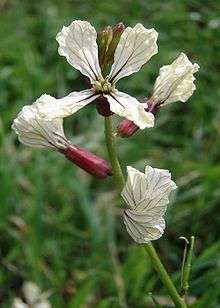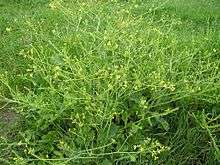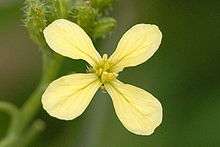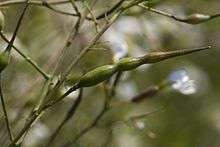Raphanus raphanistrum
| Raphanus raphanistrum | |
|---|---|
 | |
| Scientific classification | |
| Kingdom: | Plantae |
| (unranked): | Angiosperms |
| (unranked): | Eudicots |
| (unranked): | Rosids |
| Order: | Brassicales |
| Family: | Brassicaceae |
| Genus: | Raphanus |
| Species: | R. raphanistrum |
| Binomial name | |
| Raphanus raphanistrum | |

Raphanus raphanistrum, (the wild radish, white charlock or jointed charlock) is a flowering plant in the family Brassicaceae. It is sometimes claimed to be the ancestor of the edible radish, Raphanus sativus. Native to western Asia, Europe and parts of Northern Africa. It has been introduced into most parts of the world, and is regarded as an habitat threatening invasive species in many areas, for example Australia. It spreads rapidly, and is often found growing on roadsides or in other places where the ground has been disturbed.
Description
Wild radish grows as an annual or biennial plant, with a single taproot which is similar to that of the cultivated radish but less enlarged. It has basal leaves that are oblong-elliptic to spatula-shaped, the stem leaves are shorter and lobed.[1] It has hairy stems and can grow up to between 20–60 mm (0.79–2.36 in) tall.[2] It blooms between May and September, in the UK,[2] or between June and August, in the US.[1] The flowers very similar to those of the searocket, which is found in some of the same regions (in the US) and is easily distinguished from it by having thinner, non-succulent stems and leaves. The stems have wide spaced, four-petalled flowers 30–40 mm (1.2–1.6 in) across and varying in colour, usually from white to purple but sometimes light orange to yellow, often with colour shading within a single petal.[1] Later, on a short stalk,[1] it produces a podded seed capsule. Up to 8 round jointed pods, each containing one round or oval seed.[2]
Taxonomy
It was formally described by the Swedish botanist Carl Linnaeus in his seminal publication 'Species Plantarum' on page 669 in 1753.[3][4][5]
The genome of wild radish is estimated to be ~515 Mb. Approximately 49% of the genome (254 Mb) has been sequenced.[6] researchers found evidence of a past whole-genome triplication in wild radish followed by widespread gene loss, resulting in ~38,000 genes in the genome of the extant species.
It has 3 known subspecies such as;
- Raphanus raphanistrum subsp. landra (Moretti ex DC.) Bonnier & Layens
- Raphanus raphanistrum subsp. rostratus (DC.) Thell.
- Raphanus raphanistrum subsp. sativus (L.) Domin[4]
It has several common names including jointed charlock,[1] jointed radish, jointed wild radish, sea radish, white charlock,[2] and wild radish.[5][7]
It is often erroneously identified as mustard.
Distribution and habitat

It is native to temperate regions of North Africa, Europe and parts of Western Asia.[5]
Range
It is found in North Africa, within Macaronesia, Madeira Islands, Canary Islands, Algeria, Egypt, Libya, Morocco and Tunisia. Within Western Asia it is found in the Caucasus, Armenia, Azerbaijan, Cyprus, Georgia, Iran, Iraq, Israel, Jordan, Lebanon, Syria and Turkey. In eastern Europe, it is found within Belarus, Estonia, Latvia, Lithuania, Moldova and Ukraine. In middle Europe, it is in Austria, Belgium, Czech Republic, Germany, Hungary, Netherlands, Poland, Slovakia and Switzerland. In northern Europe, in Denmark, Finland, Ireland, Norway, Sweden and United Kingdom. In southeastern Europe, within Albania, Bosnia and Herzegovina, Bulgaria, Croatia, Greece, Italy, Macedonia, Montenegro, Romania, Serbia and Slovenia. Also in southwestern Europe, it is found in France, Portugal and Spain.[5]
Ecology

It is frost hardy, and even hard freezes only temporarily interrupt bloom. In Australia, it is regarded as an habitat threatening invasive species in many areas.[8] In Canada, it is a naturalised species and sometimes hybridizes with cultivated radish, R. sativus. It is also proved to be resistant to several herbicides.[9] In southeastern USA, the pale yellow form is common, sometimes entirely taking over fields in wintertime. Although, it is a significant source of pollen and nectar for a variety of pollinators, especially honey bees during the very early spring starting buildup. Female Andrena agilissima,or mining bees, frequent this plant to obtain pollen and nectar.[10] Other pollinators include cabbage butterflies and a few syrphid fly species.[11]
References
- 1 2 3 4 5 "Raphanus raphanistrum (Jointed Charlock)". Minnesota Wildflowers. Retrieved 8 November 2017.
- 1 2 3 4 Reader's Digest Field Guide to the Wild Flowers of Britain. Reader's Digest. 1981. p. 40. ISBN 9780276002175.
- ↑ "Brassicaceae Raphanus raphanistrum L." ipni.org. Retrieved 8 November 2017.
- 1 2 "Raphanus raphanistrum L. is an accepted name". 23 March 2012. plantlist.org. Retrieved 8 November 2017.
- 1 2 3 4 "Taxon: Raphanus raphanistrum L." ars-grin.gov. Retrieved 8 November 2017.
- ↑ Moghe, Gaurav (May 2014). "Consequences of Whole-Genome Triplication as Revealed by Comparative Genomic Analyses of the Wild Radish Raphanus raphanistrum and Three Other Brassicaceae Species". The Plant Cell. doi:10.1105/tpc.114.124297. PMC 4079359.
- ↑ "Raphanus raphanistrum". Natural Resources Conservation Service PLANTS Database. USDA. Retrieved 18 October 2015.
- ↑ Peltzer, Sally. "Wild radish". Western Australia Department of Agriculture and Food. Retrieved 10 November 2015.
- ↑ Warwick, Suzanne I.; Francis, Ardath (3 February 2005). "The biology of Canadian weeds. 132. Raphanus raphanistrum. L." Eastern Cereal and Oilseed Research Centre. Retrieved 8 November 2017.
- ↑ Giovanetti, Manuela; Lasso, Eloisa (July–September 2005). "Body size, loading capacity and rate of reproduction in the communal bee Andrena agilissima (Hymenoptera; Andrenidae)". Apidologie. 36 (3): 439–447. doi:10.1051/apido:2005028.
- ↑ Koelling, Vanessa A.; Karoly, Keith (May 2007). "Self-pollen interference is absent in wild radish (Raphanus raphanistrum, Brassicaceae), a species with sporophytic self-incompatibility". Am. J. Bot. 94 (5): 896–900. doi:10.3732/ajb.94.5.896. Retrieved 8 November 2017.
External links
| Wikimedia Commons has media related to Raphanus raphanistrum. |
- Genome and transcriptome resources for Raphanus raphanistrum on NCBI
- Jepson Manual Treatment
- USDA PLANTS database entry
- Comprehensive profile for Raphanus raphanistrum from MaltaWildPlants.com
- Washington Burke Museum
- UC Davis IPM
- Photo gallery
- Raphanus raphanistrum Flowers in Israel